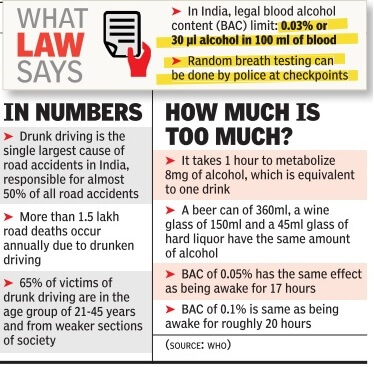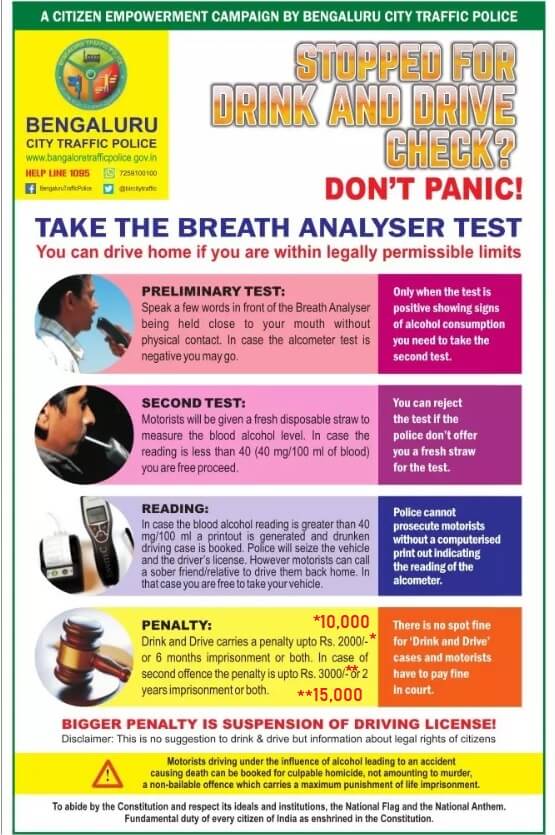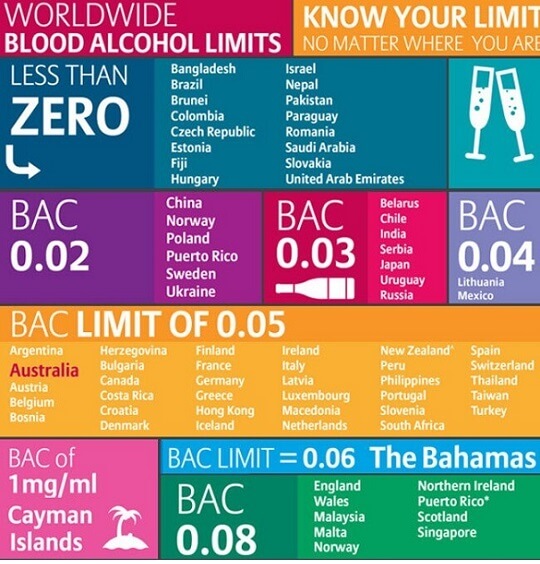When you drink and drive You’re endangering yourself and everyone else. You’re much more likely to have an accident and kill someone. Drunken driving or driving under the influence, (DUI) is a criminal offence and it has severe consequences. This article tries to answer What happens if you are caught driving after drinking, Drunk Driving Fines, how does one have to pay fine, What is there is an accident, famous cases of hit and run, Sanjeev Nanda and Salman Khan. What is Alcohol, How do breath analyzers work? What is BAC or Alcohol limit across world?

What Law says about drunk driving
Table of Contents
What happens if you are caught driving after drinking
In India, there is no uniformity with respect to laws related to drinking and it varies from one State to another. So the legal drinking age or the sale and consumption of alcohol vary from state to state(given later in the article). But the following laws are common across India.
If the police officer suspects you have been drinking,
- you are required to use the breath analyzer on the spot.
- If the level of BAC(Blood Alcohol Content) is above 30 mgs/100ml(practically 40 mg/100 mil), the police are supposed to book you under DUI( Driving under Influence).
- There is no spot fine for drunk driving.
- The offender’s Driving License (DL) and Car’s Registration Copy (RC) is seized.
- The vehicle may also be taken.
- The police gives notice/receipt, the driver has to go to court to pay a fine.
- The punishment for drunk driving is six month’s imprisonment or payment of a fine up to Rs. 10,000 or both. If the offender is caught committing the offence a second time, he will have to face imprisonment of two years or a fine up to Rs.20,000 or both. Hence many pay the police as the process is time-consuming and involves going to court.
If there is an accident or If you damage another person’s vehicle or property or individual then the other person, called as the third party, can file a claim for compensation for damage, injury, death caused by your vehicle a car or motorbike.
- The case for claiming compensation under the third party will be filed against the car owner who hit and his insurance company. The case will be filed with special court Motor Accidents Claims Tribunal through motor claims lawyer. Civil courts cannot decide road accident compensation claims.
- If a person gets involved in a fatal accident, he will be booked for culpable homicide, which is a non-bailable offence.
Test for Drunk Driving, BreathAnalyser
Police have certain hotspots where they install barricades and conducts checks. If you are stopped by a traffic police official, park your car/bike at the side and coordinate with the police officer. The officer might ask you some generic questions, answer them honestly. The police usually ask for the details and Driving License(DL) and vehicle’s Registration Copy(RC).
If the police officer suspects you have been drinking, you are required to use the breathanalyzer on the spot. The Breath analyzers do not directly measure blood alcohol content or concentration, which requires the analysis of a blood sample. Instead, they estimate BAC(Blood alcohol content) indirectly by measuring the amount of alcohol in one’s breath. You have to blow into the BreathAnalyser through a detachable straw.
The limit of Blood alcohol content in India is 30 mgs/100ml(often police officers give the benefit of the doubt up to 40mgs/100ml) If the level is above 30 mgs/100ml(practically 40 mg/100 mil), the police is supposed to book you under DUI( Driving under Influence). Routinely traffic policemen encounter drunk drivers with two-and-a-half times that limit.
Don’t abuse, harass or physically assault the officers. They can charge you under the Indian Motor Vehicle Act (IMV) act 185 (1) and Indian Penal Code(IPC) if you behave badly
-
- Rash driving under IPC 279
- Assaulting and causing injury to a police officer under IPC 332.
- Obstructing a public servant from doing his duty under IPC 353.
- Causing an accident by drinking and driving under IPC 304.

Info about the Breath Analyser Test
Drunk Driving Fines
There is no spot fine for drunk driving. The police give notice/receipt, the driver has to go to court to pay a fine. Hence many pay the police as the process is time-consuming and involves going to court.
Ensure the receipt is printed properly. Breath Analyzer reading should be clearly visible. It should have a signature from the witness available at the spot along with the address.
The offender’s Driving License (DL) and Car’s Registration Copy (RC) is seized. The vehicle may also be taken.
After being issued a notice, the motorist is not allowed to drive. Your co-passenger can drive if he/she is sober and have a valid DL. Or, you can call anyone who is sober and having a valid DL to drive the vehicle. Else you will have to leave the vehicle behind and take a cab home.
If the vehicle is seized, police have to do spot inspection report (mahajar), has to put the PF (property form) number and submit it to the court. The vehicle will be be released to the owner only with the court order.
The punishment for drunk driving is six month’s imprisonment or payment of a fine up to Rs. 10,000 or both. If the offender is caught committing the offence a second time, he will have to face imprisonment of two years or a fine up to Rs.20,000 or both.
Paying Fine in Court
Appear at the traffic police station next working day to see if your charge sheet is sent to the court.
You get a Crime Register Number(CR number). (It is suggested to get the name of the police officer)
You need to go to the court to pay the fine, within 15 days. Many go on the next working day (Check if your case has reached court. If it hasn’t you need to go back again after some time.). If the motorist fails to appear in court, a warrant will be issued and he will have to face arrest or stiffer penalties.
Search for an advocate/lawyer to handle your case. Lawyer fees are around Rs 500 – Rs 1000.
You appear before the judge with your lawyer.
- Just answer any basic questions he might ask. The judge tells you the amount.
- Tip : Go in semi-formals and shoes. A guy was returned back because he was in the court in shorts after waiting for 5 hours for his turn.
- Don’t talk much. Answer only what you’re asked. Don’t hurt the ego of anyone in court as you’re in their mercy.)
Then you have to deposit the fine. You get a receipt.
You need to take the receipt and go the traffic control office in the area
If the Particular Inspector whose name is mentioned in your violation ticket (He is the person who has charged this violation against you) is not available at the station you will have to wait for him to come and release your vehicle if it was confiscated on the day of Drink and Drive. You might have to pay the Inspector when he is releasing your vehicle from the yard(around Rs 500)
In Kerala, enforcement of DUI is even stricter. The drunk driver is immediately removed from the vehicle and taken to a jurisdictional police station. He would remain there, till two tax-paying citizens stand bail, or till he gets produced before a judicial magistrate. The magistrate issues the fine, which generally is around 3000 Rs. The drunk driver also needs to attend a counselling session (done by NGO) before the impounded license is given back.
Quora: What happens When you drunk and drive in Bangalore
Is drink and drive a criminal offence?
Drunken Driving Case is an offence under the Motor Vehicle Act 1988. Such cases come under violations of law not amounting to criminal offences. When applying for any post, the candidate is not obliged to mention such violations but asked to mention only such criminal offences which resulted in a jail term.
It will not be reflected in your Police Verification for Passport, Job etc. As long as you are caught before causing any serious accident, this offence will not affect your career prospects.
Drive and Drink Accident, Motor Accidents Claims Tribunal, Third Party Insurance
if one is involved in a car/bike crash and the accident turns out to be insured’s fault, then the liability to the driver of the other car/bike , the property would be covered. Under third-party motor insurance the insurance company agrees to indemnify the insured person, if he is sued or held legally liable for injuries or damage was done to a third party. However, one would be unable to claim for the damage to one’s own car. As explained in our article Difference between Third Party and Comprehensive Insurance Policy for Cars and Bikes Third-party motor insurance covers against
- Death or bodily injury to a third party
- The accidental death of a third-party
- Damage to third party property
- Permanent total disability of a third-person
The application for a third-party claim can be made against the vehicle owner by the victim, the owner of the property, or the legal envoy of the deceased. The other steps are:
- Post completion of the third-party claim application, an FIR must be filed with the police.
- The first information report must include the following details:
- Registration number of the vehicle involved, in case of an accident
- The license number of the driver
- Name and contact details of witnesses, if any.
- Subsequently, the claimant should file a case with the Motor Accident Claims Tribunal, under the jurisdiction of the area where the petitioner resides, the accident occurred, the residence of the driver or owner of the vehicle
- The documents like copy of the FIR and the original records of expenses incurred by the applicant must be submitted as proof of damage/loss
- Medical expenses can also be claimed for treatment of the injury that was the cause of death.
- For vehicle or property damage, one needs to quantify the loss so motor vehicle inspection report, surveyor’s report and original bills are required.
- The court then hears both the sides, examines the evidence, and fixes the liability. One has to establish the other party’s fault. After the court decides the full amount the insurance firm has to pay the total compensation
- The total compensation is reimbursed by the car insurance firm based on the court directive.
- But As per IRDA norms, there is a limit to damages covered for damage to other vehicles. If damages are more than the upper limit, the balance has to be paid by the policyholder himself.
- The third-party damages are covered up to a sum of Rs. 1 lakh for 2 wheelers.
- The third-party damages are covered up to a sum of Rs. 7.5 lakh for 4 wheelers.
In third-party claims involving bodily injury or death, the turnaround time is one to two years.
Sanjeev Nanda Drunken Driving, Hit and Run Case in 1999
In 1999, Sanjeev Nanda, grandson of Indian Navy Chief and son of Indian arms dealer Suresh Nanda ran over and killed six people, including three police officers. While Nanda and several related parties were initially acquitted and released in a trial in 1999, Nanda was later found guilty in 2008 and sentenced to two years in prison, which was reduced to time served, a large fine, and two years of community service by the Indian Supreme Court in 2012.
The case inspired the Bollywood movie Jolly LLB (2013) starring Arshad Warsi and Boman Irani. The following video shows the scenes featuring Judge Sundar Lal Tripathi.
Salman Khan Hit and Run Case 2002
The incident took place on September 28, 2002, Salman Khan’s Land Cruiser crashed into American Express bakery in Bandra, killing one person and injuring four. His blood samples were taken which showed he drank more than the permissible limit(62 mg). Subsequently, he was arrested but was granted bail soon after.
The case dragged on for many years with the court trying to decide if the charge of culpable homicide(Section 304 (Part II) ) not amounting to murder was applicable or not. There were the incident of files missing from the Bandra police station, death of eyewitness Ravindra Patil(Mumbai police officer who was assigned to Salman Khan as an acting bodyguard. He had filed the first FIR, died of TB on 3 Oct 2007). After 13 years Salman Khan claiming that he was not driving, and it was his driver, Ashok Singh who was driving.
On 6 May 2015, the Mumbai Sessions court found Salman Khan guilty for seven charges, including the death of one of the victims. Salman Khan was sentenced to five years in prison but was granted bail.
On 10 Dec 2015, the Bombay High Court acquitted Khan of all criminal charges for a lack of substantial evidence. The Court completely disregarded the evidence given by the eyewitness Ravindra Patil. The court concluded that the prosecution could not prove the actor’s guilt beyond a reasonable doubt. It could not prove that the actor was under the influence of alcohol or was driving. The Court did not accept Singh’s version that was driving and not the actor. The trial court had noted that Singh had appeared after 13 years of the incident to the court.
Salman Khan was charged with various provisions under IPC, Motor Vehicles Act, 1988 and Bombay Prohibition Act, 1949 as follows
- Section 304 (Part II) of Indian Penal Code (IPC) – culpable homicide not amounting to murder (max 10 years in jail).
- Sec 279 of IPC – Rash and negligent driving (max 6 months in jail).
- Sec 337 of IPC – Causing hurt by act endangering life (max 2 years in jail).
- Sec 338 of IPC – Causing grievous hurt (max 2 years in jail).
- Sec 427 of IPC – Mischief cause danger to property (max 2 years in jail).
- Sec 34 (a), (b) of Motor Vehicle Act read with 181 and 183 – Driving vehicle in contravention to the rules & Driving after consuming alcohol respectively. Bombay Prohibition Act – Driving under influence (max 6 months in jail).
More details at Analysis of Salman Khan’s Hit and Run Case
Basic Facts about Drinking: Legal Age, Alcohol Limits, Breath Analyzer
When you drink and drive You’re endangering yourself and everyone else. You’re much more likely to have an accident and kill someone.
What is Alcohol?
The term “alcohol” in its purest sense denotes “ethyl alcohol or ethanol”, a liquid which is obtained from the action of yeast on sugar, but in colloquial terms, it usually refers to “a drink such as beer, wine and whiskey that can make people drunk”.
An alcoholic beverage is a drink what typically contain 3%-40% alcohol(ethanol). Alcohol in carbonated beverages is absorbed faster than alcohol in non-carbonated drinks. There are 2 classes:
- Fermented beverages: produced by fermentation of food grain or fruits e.g.:-beer, wine, palm wine, tonto, sonti, mead, cider, kilju, chicha etc
- Distilled beverages: produced by distilling ethanol produced by means of fermenting grains, fruits, vegetables etc e.g.:-vodka, gin, tequila, rum, brandy, whisky, soju, baiju etc
Percentage of Alcohol differs in beverages like beer, whiskey, vodka. The unit used is ABV (Alcohol by Volume), the number of millilitres (mL) of pure ethanol present in 100 mL of solution at 20 °C (68 °F).
- Beer: 5 to 15%
- Whiskey: 40 to 43%
- Vodka: 40 to 43%
How is Alcohol limit measured?
The amount of alcohol that is contained within the bloodstream can be measured by testing a small sample of blood or urine, or through analysis of exhaled breath. The amount of alcohol within the bloodstream is described in terms of BAC, Blood Alcohol Content
BAC is usually measured as milligrams of alcohol per 100 millilitres of blood (mg/100 ml). But other units used are grams of alcohol per 100 millilitres of blood (g/100 ml), grams of alcohol per decilitre (g/dl), milligrams of alcohol per deciliter (mg/dl) or another appropriate measure.
Legal BAC levels for driving vary from country to country, or state to state, throughout the world – ranging from 20 mg/100 ml to 10 mg/100 ml
Effects of Alcohol on Body
The immediate effects of alcohol on the brain are either depressing or stimulating in nature, depending on the quantity consumed. Alcohol results in an impairment it produces a poor judgement, increased reaction time, lower vigilance and decreased visual acuity. Physiologically, alcohol also lowers blood pressure and depresses consciousness and respiration. Alcohol also has analgesic and general anaesthetic properties. Following image from WHO report Drinking and Driving shows the effects of alcohol on the body based on the amount consumed

Effects of Alcohol on Body
Legal Drinking Age in India
In India, the legal age for drinking varies from 18 years to 25 years from state to state, while some states have completely banned alcohol.
- For instance, states like Goa, Himachal Pradesh, Karnataka and others have a legal drinking age of 18 years.
- States like Delhi, Haryana and others have a legal drinking age of 25 years, while most states have a legal drinking age of 21 years.
- Consumption of alcohol is completely banned in the states of Gujarat, Bihar, Manipur and Nagaland, as well as the union territory of Lakshadweep.
What is Alcohol Limit in India?
Blood alcohol limits vary significantly around the world, shown in the image below.
- In India, the permissible blood alcohol content (BAC) is set at 0.03% per 100ml blood. So Any person who in his/her blood has alcohol exceeding 30 mg. per 100 ml. of blood, detected in a test by a breath analyser is said to be driving under the influence or drunk driving.
- Figures will vary for everyone, but for ready reference, an average male weighing about 65kg can theoretically stay within the legal limit if he consumes two pints of beer (equivalent to 660 ml), or one large whiskey peg (60 ml), or two glasses of wine (200 ml).
- The body takes about an hour to process 29.5 ml of alcohol. Since every type of liquor has a different alcohol content, to be able to drive again without your reason and coordination being affected by it, you must wait for at least 90 minutes after a pint of beer and three hours after a large whisky or two glasses of wine.
The image below shows the BAC limit across the world

World wide BAC or alcohol limit
How can one measure how much Alcohol one has consumed?
The amount of alcohol that is contained within the bloodstream can be measured by testing a small sample of blood or urine, or through analysis of exhaled breath
Alcohol that a person drinks shows up in the breath because it gets absorbed from the mouth, throat, stomach and intestines into the bloodstream. Alcohol is not digested upon absorption, nor chemically changed in the bloodstream. As the blood goes through the lungs, some of the alcohol moves across the membranes of the lung’s air sacs (alveoli) into the air, because alcohol will evaporate from a solution — that is, it is volatile. The concentration of the alcohol in the alveolar air is related to the concentration of the alcohol in the blood

How Alcohol reaches lungs
BreathAnalyser is a device for estimating blood alcohol content. The driver blows into a disposable mouthpiece for each test. The whole process takes about a minute for the device to record the result.
Breath analyzers do not directly measure blood alcohol content or concentration, which requires the analysis of a blood sample. Instead, they estimate BAC indirectly by measuring the amount of alcohol in one’s breath. Like Xerox, Google etc Breath analyser is the brand name but it is used generally. BreathAnalyser was developed by Robert Frank Borkenstein. It was registered as a trademark on May 13, 1954
There are three major types of breath alcohol testing devices, and they’re based on different principles:
- Breathalyzer – Uses a chemical reaction involving alcohol that produces a color change
- Intoxilyzer – Detects alcohol by infrared (IR) spectroscopy
- Alcosensor III or IV – Detects a chemical reaction of alcohol in a fuel cell
Regardless of the type, each device has a mouthpiece, a tube through which the suspect blows air, and a sample chamber where the air goes. The rest of the device varies with the type. The Video below talks in detail about How Do Breathalyzers Work? Or One can read How Stuff works article on How Breath Analyzers work.
WHO report Drinking and Driving
Related Articles:
DO NOT DRINK AND DRIVE – Please practise and advise the same.




I agree with you